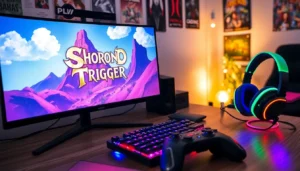Table of Contents
ToggleIn a world dominated by high-definition graphics and ultra-realistic visuals, retro pixel art sprites are making a glorious comeback. These charming little characters, born from the 8-bit and 16-bit eras, have a way of tugging at the heartstrings of gamers and artists alike. They may be simple, but they pack a nostalgic punch that can transport anyone back to simpler times—think Saturday mornings spent glued to the screen, battling pixelated foes.
Overview of Retro Pixel Art Sprites
Retro pixel art sprites feature a distinctive visual style that harkens back to the 8-bit and 16-bit gaming eras. These sprites consist of simplistic, blocky graphics that capture the essence of early video games. Many developers and artists utilize this nostalgic art form to evoke emotions tied to classic gameplay experiences.
The charm of pixel art sprites lies in their ability to create vibrant characters and immersive worlds using limited colors and resolution. Each sprite tells a story, drawing players into the pixelated game world with its unique designs. Fans appreciate these visuals for their artistic merit and the nostalgia they inspire.
In modern gaming, the resurgence of retro pixel art reflects a love for simplicity and creativity. Indie developers frequently adopt this style, blending it with contemporary gameplay mechanics to create engaging experiences. Projects like “Stardew Valley” and “Celeste” showcase how pixel art can coexist with modern design principles while still appealing to a broad audience.
Various tools enable artists to create their own retro pixel art sprites. Software like Aseprite and Piskel simplifies the process, allowing creators to experiment with colors and characters easily. Online communities often share tips, tutorials, and resources, fostering collaboration among fans and artists.
This art style transcends gaming by influencing visual design in multiple domains, including web design and animation. Retro pixel art’s legacy emphasizes creativity and resourcefulness, encouraging creators to explore new possibilities within a familiar framework. The lasting impact of pixel art sprites continues to resonate, proving their relevance in today’s digital landscape.
History of Pixel Art

Pixel art emerged as a distinctive art form in the early days of computing and gaming, shaping visual styles that resonate with creators today.
Early Beginnings
In the late 1970s, pixel art started as a necessity due to technological limitations. Game developers like Atari and Nintendo used simple graphics. These minimal designs provided a unique aesthetic for groundbreaking titles such as “Pong” and “Super Mario Bros.” Sprites, consisting of small grids of colored pixels, created recognizable characters and settings within tight memory constraints. Artists learned to convey emotions and actions through limited resolution, leading to a creative challenge that motivated innovation.
Evolution Through the Decades
The 1980s and 1990s marked significant growth in pixel art’s complexity and popularity. As technology advanced, graphics transitioned from 8-bit to 16-bit systems, improving visual fidelity. Notable games like “The Legend of Zelda” and “Sonic the Hedgehog” showcased this evolution, incorporating richer colors and more detailed animations. Retro-inspired titles continued to emerge in the 2000s, with indie developers embracing pixel art for its nostalgic quality. Projects like “Mega Man” and “Castlevania” influenced modern game design, inspiring new generations of artists to explore pixel art within contemporary styles and gameplay mechanics.
Characteristics of Retro Pixel Art Sprites
Retro pixel art sprites showcase distinct features that celebrate nostalgic gaming aesthetics. This style employs a unique blend of simplicity and creativity.
Color Palette and Limitations
Limited color palettes define retro pixel art. Typically, artists use only 16 to 256 colors to create their sprites, especially inspired by the capabilities of early gaming consoles. By focusing on fewer colors, these sprites evoke a sense of charm and nostalgia. Artists often rely on strategies like dithering to create shading effects, enhancing depth despite restrictions. These limitations encourage creativity, pushing artists to utilize contrasting colors and pixel arrangements effectively. Classic titles such as “Pac-Man” and “Mega Man” exemplify the engaging effects of such constrained palettes.
Key Design Elements
Distinct features characterize retro pixel art sprites, emphasizing blocky shapes and pixelated aesthetics. Designers frequently rely on a grid-based structure for sprite creation, with each sprite typically made up of an 8×8 to 32×32 pixel grid. Such constraints lead to exaggerated and stylized forms, ensuring clear recognition of characters and objects. Iconic sprites, like those from “Final Fantasy” and “Castlevania,” exhibit strong silhouettes that enhance visibility. Artists often incorporate limited animations, usually through frame-by-frame techniques, adding dynamism within a minimalist framework. Recognizable symbols and expressions contribute to conveying personality, captivating players with simplistic yet effective design choices.
Popular Games Featuring Pixel Art Sprites
Pixel art sprites have found their place in both classic and modern games. These visual elements enhance gameplay, making experiences more engaging and nostalgic.
Classic Titles
Classic games from the 8-bit and 16-bit eras prominently featured pixel art sprites. “Super Mario Bros.” showcased the charm of simplistic character designs with vibrant colors and recognizable shapes. “The Legend of Zelda” utilized pixel art to create captivating worlds filled with adventure. Similarly, “Sonic the Hedgehog” introduced fast-paced gameplay through its iconic, pixelated characters. Retro titles relied on pixel art due to technological limitations, making these simplistic visuals memorable for generations of gamers.
Modern Games with Retro Aesthetics
Modern games continue to embrace pixel art aesthetics, blending nostalgia with contemporary gameplay. “Stardew Valley” presents pixelated graphics yet delivers a deep farming simulation experience. “Celeste” utilizes pixel art to create heartfelt storytelling alongside challenging platforming mechanics. Indie developers thrive on this style, as seen in titles like “Katana ZERO,” which combines vibrant visuals with engaging narratives. Tools such as Aseprite allow artists to craft their pixel art, fueling creativity and innovation within this genre. The resurgence of pixel art reflects a collective yearning for simplicity amidst today’s fast-paced gaming landscape.
The Impact of Retro Pixel Art on Modern Gaming
Retro pixel art significantly influences modern gaming, shaping aesthetics and gameplay experiences. Nostalgia drives the appeal, as gamers connect emotionally with the graphics reminiscent of classic titles. These sprites encourage indie developers to blend traditional visuals with innovative mechanics, leading to successful projects such as “Stardew Valley” and “Celeste.”
A shared sense of community emerges around retro pixel art. Artists utilize tools like Aseprite and Piskel to collaborate on projects, fostering a vibrant online culture. This interaction boosts creativity as new ideas evolve within familiar artistic constraints. The legacy of pixel art extends to web design and animation, demonstrating its versatility beyond gaming.
Historical context adds depth to understanding retro pixel art’s relevance. Early gaming platforms, like those from Atari and Nintendo, laid the groundwork with iconic titles such as “Pong” and “Super Mario Bros.” Innovations in technology throughout the late 20th century expanded possibilities, paving the way for distinct styles present in games like “The Legend of Zelda” and “Sonic the Hedgehog.”
Characteristics inherent to retro pixel art enhance player engagement. Utilizing limited color palettes—ranging from 16 to 256 colors—artists craft charming visuals that evoke nostalgia. Distinct design elements, including blocky shapes and grid-based structures, emphasize character recognition in beloved games like “Final Fantasy” and “Castlevania.”
Many modern games incorporate retro pixel art, capturing the hearts of new generations. Titles like “Stardew Valley” and “Celeste” illustrate how this aesthetic fusion enriches gameplay experiences while appealing to nostalgic players. Demand for simplicity persists in today’s fast-paced gaming environment, affirming the lasting impact of retro pixel art on the industry.
Retro pixel art sprites hold a unique place in the hearts of gamers and creators alike. Their charm and nostalgic appeal continue to inspire a new generation of artists and developers. As modern technology advances, the simplicity of pixel art serves as a reminder of gaming’s roots while allowing for innovative storytelling and design.
The community surrounding retro pixel art thrives on collaboration and creativity, fostering an environment where artists can share their passion. This enduring style not only shapes the gaming landscape but also influences various visual mediums beyond gaming. The legacy of retro pixel art is a testament to its timelessness and its ability to resonate across generations.




